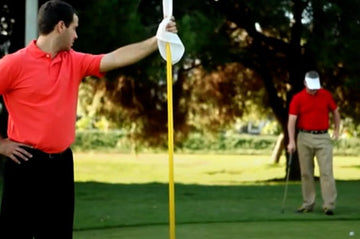Golf Tips: Grain and Putting Greens
by
Jeremiah Bohannon
on
Oct 20, 2014

Ever hit a putt which broke one direction but the slope of the green read to break in the other direction? Ever hit a putt which you thought should be fast but was much slower, even though it was downhill? Ever hit a putt which should have been slow, but for some unknown reason is was considerably faster?
If you’ve run into the above scenarios, or similar, you may need to learn a bit about “grain.” Some grass types on greens have a “grain” to them. Grain occurs when the blads of grass lay down in a certain direction. The ball rolls faster “with the grain,” meaning rolling in the direction the blades are laying down. The ball rolls slower “against the grain,” or “into the grain.”
Grain can affect the break of putts as well. If you read a putt to break from left-to-right, but the grain is laying right-to-left, the putt may roll straight. This can be quite puzzling to see.
Conversely, if the grain and the break were in the same direction, the putt will break more than the read would indicate.
Seeing Grain
How does one see the grain to read it? The color of the grain will be lighter or darker depending on which direction the grain is laying. “Down grain” views will be shiny and brighter as the sun is reflecting off the tops of the grass blades. “Up grain” views will be darker as the sun is not reflecting as much in the tips of the blades.
A putt may have several different grains to it, depending on the drainage of the green and the angle of the sun. Looking at a 50 foot putt one may see several light and dark areas, indicating different grain directions.
Conclusion
Now that you know a little more about grain you can hopefully make a few more putts. If a putt puzzles you as to why it broke or didn’t break, or perhaps is off on the speed, look back and try to find light and dark areas. More than likely, the miscalculation was due to the direction of the grain.
 Ever hit a putt which broke one direction but the slope of the green read to break in the other direction? Ever hit a putt which you thought should be fast but was much slower, even though it was downhill? Ever hit a putt which should have been slow, but for some unknown reason is was considerably faster?
If you’ve run into the above scenarios, or similar, you may need to learn a bit about “grain.” Some grass types on greens have a “grain” to them. Grain occurs when the blads of grass lay down in a certain direction. The ball rolls faster “with the grain,” meaning rolling in the direction the blades are laying down. The ball rolls slower “against the grain,” or “into the grain.”
Grain can affect the break of putts as well. If you read a putt to break from left-to-right, but the grain is laying right-to-left, the putt may roll straight. This can be quite puzzling to see.
Conversely, if the grain and the break were in the same direction, the putt will break more than the read would indicate.
Seeing Grain
How does one see the grain to read it? The color of the grain will be lighter or darker depending on which direction the grain is laying. “Down grain” views will be shiny and brighter as the sun is reflecting off the tops of the grass blades. “Up grain” views will be darker as the sun is not reflecting as much in the tips of the blades.
A putt may have several different grains to it, depending on the drainage of the green and the angle of the sun. Looking at a 50 foot putt one may see several light and dark areas, indicating different grain directions.
Conclusion
Now that you know a little more about grain you can hopefully make a few more putts. If a putt puzzles you as to why it broke or didn’t break, or perhaps is off on the speed, look back and try to find light and dark areas. More than likely, the miscalculation was due to the direction of the grain.
Ever hit a putt which broke one direction but the slope of the green read to break in the other direction? Ever hit a putt which you thought should be fast but was much slower, even though it was downhill? Ever hit a putt which should have been slow, but for some unknown reason is was considerably faster?
If you’ve run into the above scenarios, or similar, you may need to learn a bit about “grain.” Some grass types on greens have a “grain” to them. Grain occurs when the blads of grass lay down in a certain direction. The ball rolls faster “with the grain,” meaning rolling in the direction the blades are laying down. The ball rolls slower “against the grain,” or “into the grain.”
Grain can affect the break of putts as well. If you read a putt to break from left-to-right, but the grain is laying right-to-left, the putt may roll straight. This can be quite puzzling to see.
Conversely, if the grain and the break were in the same direction, the putt will break more than the read would indicate.
Seeing Grain
How does one see the grain to read it? The color of the grain will be lighter or darker depending on which direction the grain is laying. “Down grain” views will be shiny and brighter as the sun is reflecting off the tops of the grass blades. “Up grain” views will be darker as the sun is not reflecting as much in the tips of the blades.
A putt may have several different grains to it, depending on the drainage of the green and the angle of the sun. Looking at a 50 foot putt one may see several light and dark areas, indicating different grain directions.
Conclusion
Now that you know a little more about grain you can hopefully make a few more putts. If a putt puzzles you as to why it broke or didn’t break, or perhaps is off on the speed, look back and try to find light and dark areas. More than likely, the miscalculation was due to the direction of the grain.
 Ever hit a putt which broke one direction but the slope of the green read to break in the other direction? Ever hit a putt which you thought should be fast but was much slower, even though it was downhill? Ever hit a putt which should have been slow, but for some unknown reason is was considerably faster?
If you’ve run into the above scenarios, or similar, you may need to learn a bit about “grain.” Some grass types on greens have a “grain” to them. Grain occurs when the blads of grass lay down in a certain direction. The ball rolls faster “with the grain,” meaning rolling in the direction the blades are laying down. The ball rolls slower “against the grain,” or “into the grain.”
Grain can affect the break of putts as well. If you read a putt to break from left-to-right, but the grain is laying right-to-left, the putt may roll straight. This can be quite puzzling to see.
Conversely, if the grain and the break were in the same direction, the putt will break more than the read would indicate.
Seeing Grain
How does one see the grain to read it? The color of the grain will be lighter or darker depending on which direction the grain is laying. “Down grain” views will be shiny and brighter as the sun is reflecting off the tops of the grass blades. “Up grain” views will be darker as the sun is not reflecting as much in the tips of the blades.
A putt may have several different grains to it, depending on the drainage of the green and the angle of the sun. Looking at a 50 foot putt one may see several light and dark areas, indicating different grain directions.
Conclusion
Now that you know a little more about grain you can hopefully make a few more putts. If a putt puzzles you as to why it broke or didn’t break, or perhaps is off on the speed, look back and try to find light and dark areas. More than likely, the miscalculation was due to the direction of the grain.
Ever hit a putt which broke one direction but the slope of the green read to break in the other direction? Ever hit a putt which you thought should be fast but was much slower, even though it was downhill? Ever hit a putt which should have been slow, but for some unknown reason is was considerably faster?
If you’ve run into the above scenarios, or similar, you may need to learn a bit about “grain.” Some grass types on greens have a “grain” to them. Grain occurs when the blads of grass lay down in a certain direction. The ball rolls faster “with the grain,” meaning rolling in the direction the blades are laying down. The ball rolls slower “against the grain,” or “into the grain.”
Grain can affect the break of putts as well. If you read a putt to break from left-to-right, but the grain is laying right-to-left, the putt may roll straight. This can be quite puzzling to see.
Conversely, if the grain and the break were in the same direction, the putt will break more than the read would indicate.
Seeing Grain
How does one see the grain to read it? The color of the grain will be lighter or darker depending on which direction the grain is laying. “Down grain” views will be shiny and brighter as the sun is reflecting off the tops of the grass blades. “Up grain” views will be darker as the sun is not reflecting as much in the tips of the blades.
A putt may have several different grains to it, depending on the drainage of the green and the angle of the sun. Looking at a 50 foot putt one may see several light and dark areas, indicating different grain directions.
Conclusion
Now that you know a little more about grain you can hopefully make a few more putts. If a putt puzzles you as to why it broke or didn’t break, or perhaps is off on the speed, look back and try to find light and dark areas. More than likely, the miscalculation was due to the direction of the grain.



























